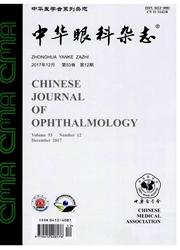

 中文摘要:
中文摘要:
目的探讨大鼠青光眼视神经损害的机制。方法实验研究。将8~12周大鼠的视神经筛板作为研究对象,分为3组:10只健康大鼠的右眼为组1、左眼为组2,13只右眼高眼压大鼠的对侧眼为组3。所有大鼠均经电镜固定液灌注、固定并常规电镜包埋制片,做1.5μm连续半薄切片;组1和组2各10根视神经及组3的11根视神经做横向,组3的2根做纵向切片。在筛板区中部行超薄切片,采用光镜和电镜观察大鼠视神经筛板区的形态和结构。3个组大鼠视神经筛板区间隙为(-)、(+)、(++)的眼数经非参数Kruskal—Wallis检验,采用Bonferroni法分别行各组间两两比较。结果组1、组2及组3大鼠视神经筛板区的主要支撑结构均为牢固型星形胶质细胞(AC)及其突起形成的网状胶质筛板,横切面如“肾形”,牢固型AC从腹侧粗大根部向背侧逐渐分支变细,在结构上划分为根部、放射状分支部、终端前部和终端部;突起具有独特的高电子密度,富含微丝和微管,特别是大量微丝集结成束状微丝芯构成牢固型AC的支架;在胶质筛板的背侧存在青光眼易损区,该区存在的间隙分为(-)、(+)、(++)3级,组1的10只眼中间隙为(-)、(+)和(++)的分别有1、6、3只眼;组2的10只眼中间隙为(-)、(+)和(++)的分别有l、5、4只眼;组3的11只眼中间隙为(-)、(+)和(++)的分别有1、7、3只眼。(-)、(+)、(++)在组l、组2及组3所占的比例差异均无统计学意义(X2=3.35,P:0.187;组1与组2相比,Z=-1.048,P=0.294;组1与组3相比Z=-1.691,P=0.091;组2与组3相比,Z=-1.343,P=0.179)。各组中约10%筛板结构致密间隙为(-),其与间隙为(+)和(++)的眼数差异均有统计学意义(X2=23.88,P〈0.05;(-)与(+)相比,Z=-2.821,P=0.005;
 英文摘要:
英文摘要:
Objective To explore the mechanism of optic nerve damage in glaucoma by study on structure of glial lamina cribrosa( LC ) in rats. Methods Experimental study. Albino Swiss(AS) rats were divided into 3 groups. Bilateral eyes of 10 normal rats were employed to be group Ⅰ ( right eye ) and group Ⅱ (left eye). Group Ⅲ was from the left eyes of 13 rats underwent artificially intraocular hypertension in the right eyes. All rats were perfused and fixed with electronic microscopy fixative (2% paraformaldehyde + 2% glutaraldehyde). Trimmed optic nerves were embedded with resin. Serial 1.5 μm thick 'semithin' sections were cut, either (2 eyes from group m ) longitudinally, through the optic nerve head (ONH) from the retinal end to the commencement of the optic nerve, or (31 eyes) transversely (cross-sections). Ultrathin sections were cut in the middle of glial LC. The morphological observation of glial LC was obtained by light microscopy and transmission electron microscopy. Bonferroni correction was used to cownteract the multiple comparision of each group. Results Fortified astrocytes formed the main supportive structure of glial LC in all rats, including group Ⅰ , group Ⅱ and group m. Astrocytes were ranked as a fan-like radial array, firmlyattached ventrally to the sheath of the LC by thick basal processes, but dividing dorsally into progressively more slender processes with only delicate attachments to the sheath. These fortified astrocytes form ventral stout basal end feet, radial array, axon free-'preterminal' layer before terminating in a complex layer of fine interdigitating delicate branches at the dorsal. LC astrocytes were highly and uniformly electron dense throughout all the cell processes. An equally striking feature of the astrocytic processes was their massive cytoskeletal 'strengthening' of longitudinal massed filaments and tubules. Especially, massive filaments accumulated as cytoskeletal cores to form 'scaffold' of fortified astrocytes. Th
 同期刊论文项目
同期刊论文项目
 同项目期刊论文
同项目期刊论文
 期刊信息
期刊信息
